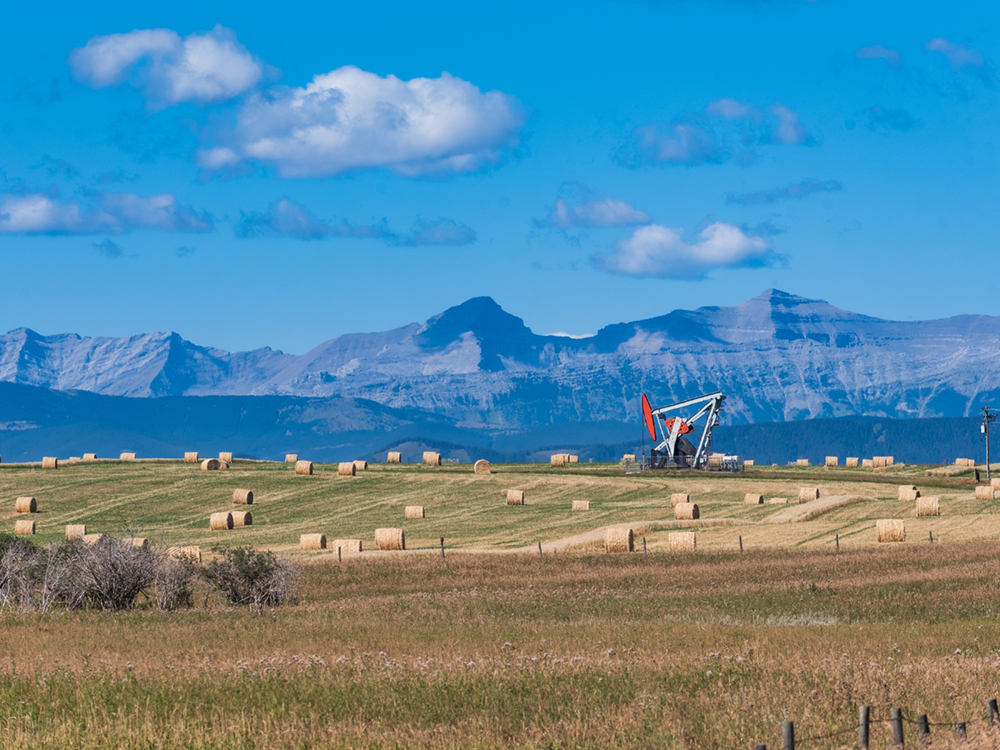The Alberta government’s recent rules for renewable energy projects are strict.
Projects are banned on prime agricultural land, unless both crops and livestock can coexist with the wind turbines or solar panels. A ban on projects in 35-kilometre zones around what the government defines as “pristine viewscapes” has blocked wind project construction in those regions. The entire length of the Rocky Mountains is included in these buffer zones. Remember that.
Then there are the bonds or securities required by developers for reclamation costs.
These stringent rules would make sense if they were consistent across the energy and resource board. They’re not. The Danielle Smith government seems to think renewables development presents a threat far greater than other, more established industries.
That’s despite the conclusions from the Alberta Utilities Commission, responsible for renewables regulation, that diverge from Smith’s terrified visions of things like solar panels choking out fields needed for crops.
The United Conservative Party government’s sudden eco-consciousness sticks out as renewables-specific, given all the messes the oil and gas industry has managed to leave in its wake.
That includes 90,000 orphan oil wells needing remediation and reclamation, and two trillion litres of toxic tailings in poison pools along a 257-kilometre stretch around the Athabasca River.
A recent release from the Alberta Wilderness Association highlighted the disparity in the government’s approach to the two energy sources.
“There is a need for consistent regulation within the energy sector. Renewable energy should not be developed in sensitive ecosystems, or in areas with high biodiversity. However, these restrictions must be applied fairly across all sectors, including the oil and gas industry,” the statement said.
Unlike renewables, oil and gas is allowed on all agricultural classes in the province, according to the statement. That permission exists in spite of the huge amount of land and sacrifice of soil and water linked to oil and gas development.
“It can take decades to remediate soils that are contaminated by oil and gas, during which the land cannot be used for farming,” it said.
“Decommissioning of oil and gas infrastructure is also a major concern, with cleanup costs estimated to be as high as $130 billion, while barely any security has been collected. Mandatory security requirements for renewable energy development must also apply to the oil and gas sector,” the statement said.
Reviving the coal mines
Another industry treated with a gentle hand is coal. Despite its record of alarming environmental impacts, recent provincial willingness to open back up development on seemingly canned coal projects indicates a concerning ignorance to how harmful it can be for Albertans.
The Grassy Mountain mine project in particular has constantly reared its head as a source of anxiety for Albertans worried about the effects of coal mining on communities and nature.
Currently there is the ministerial order banning coal mining in the eastern slopes of the Rockies, where the project would be located. The project was rejected in 2021 by a federal-provincial joint review panel on grounds it was not in the public interest. The decision was upheld despite appeals from project author Benga Mining Limited.
Despite these decisions, the mining operation is once more a possibility. Its revival by Benga, which changed its name to Northback Holdings Corp., was made clear from an internal Alberta Energy Regulator letter stating an application from Northback was to be accepted for review.
The possibility of reopening was kicked off by a clarification Minister of Energy and Minerals Brian Jean had provided to the AER, categorizing Grassy Mountain (along with three other projects) as an “advanced coal project.”
This categorization gives exemption to the ban on coal mining, meaning companies can continue with applications to mine in the area. That’s if the company’s project had a foot in the door before the ban.
“Under MO 002/2022, an ‘advanced coal project’ is one that had submitted a project summary to the regulator for the purposes of determining whether an environmental impact assessment is required before the MO was signed,” Jean said in an email to The Tyee. Benga Mining applied for approvals back in 2015, years before the banning order.
“The definition of ‘advanced coal project’ in the MO makes no reference to the outcomes of applications,” Jean’s statement said. He emphasized that his communication with the AER neither supported nor opposed Northback’s test drilling applications.
“It should be noted that this is not an application to reopen the mine. Nor do these applications ask for permission to use or divert any water from any stream or river in Alberta. The applications before the AER ask for permission to use a limited amount of water from the existing mine pond left on Grassy Mountain from when it was actively mined during the last century.”
When asked what Northback Holdings would use that remaining water from the old mine pond for, if not their mining endeavours, Jean did not respond by publication time.
Alberta Wilderness Association conservation specialist Ruiping Luo penned the earlier quoted statement advocating for equal regulation across the energy industries in the province. Luo was perplexed as to why Grassy Mountain is once more a possibility given past provincial and federal assessment.
“It went through a review panel, that was agreed by both the province and the federal government, that this is not in the public interest. So, it’s strange to me that that would be accepted again, especially because some of their justification has been that this was proposed before some of the regulations about coal came in,” Luo said to The Tyee.
“If it’s been rejected, then that should mean that it’s no longer that same project,” Luo added.
When asked in an email why the AER was once again reviewing the mining project application despite the legal history of Grassy Mountain, AER communications person Renato Gandia pointed to Jean’s statement.
“The Minister of Energy and Minerals has clarified that once a project achieves advanced coal project status, it remains so,” Gandia wrote.
The AER decided “that Northback’s applications are associated with an advanced coal project and has accepted the applications which will be reviewed and decided at a hearing,” Gandia continued.
“The AER is using its discretion under the Responsible Energy Development Act to send the Northback applications to a hearing to ensure a transparent and well-informed technical review. The hearing will determine whether Northback can move forward with drilling and exploration at Grassy Mountain.”
Clearly “advanced project” status supersedes legal rejection. What’s unclear is why.
The difference between the government’s approach to fossil fuel and renewable regulation is made clear from the contrivance to keep Grassy Mountain and the other advanced coal projects alive. While the conservatives shudder about the calamitous effects of solar and wind on our lands, open-pit mining a beloved range of mountains isn’t such a worry.
“This idea that renewables are ruining those viewscapes — I guess my question is: How is coal mining compared to renewables in terms of the impact on these pristine landscapes?” Luo asked.
“The eastern slopes are places that a lot of people go to for recreation, and if that gets mined, you’re still losing those places,” Luo said.
Coal, renewables and water
It’s not only visuals at stake. A huge consideration, especially urgent this year, is water. Namely, the exorbitant amount needed for coal mining processes.
The Grassy Mountain Coal Project is located about seven kilometres north of the town of Blairmore, and west of the town of Crowsnest Pass. That area is on the southwestern border of Alberta, just north of the Crowsnest Highway. Like much of the south of the province, the area of Crowsnest River is under a water shortage advisory.
Drought conditions in southern Alberta are so problematic that the government has categorized multiple basins (including the Oldman River) as being in a water shortage. The Oldman River basin’s mountain runoff forecasts for the period from March to September are estimated to be “much below average to below average.” All of this to say, every litre in the water supply is vital.
The Grassy Mountain project, like all coal mining, will consume large amounts of water. Used for both washing coal to remove impurities and cooling overheated equipment, the water used climbs up to millions of gallons a day in the United States.
An article by Sarah Boon, who has a PhD in glacier hydrology, broke down how much water the Grassy Mountain project is likely to use.
“Studies out of Australia have shown that coal mines use 250 litres of freshwater and about 750 litres of recycled water per tonne of coal produced. If Grassy Mountain plans to produce 4.5 million tonnes of coal per year, that’s 1.125 billion litres of freshwater per year — not even counting the recycled water,” Boon wrote.
She also noted that since the Grassy Mountain coal will be used for steel production, it won’t be contributing to Alberta’s power mix. That’s not necessarily a bad thing, given the dangers to human health endemic to coal power generation.
Droughts are getting increasingly worse in the south; last year we reached a point where water had to be trucked into communities to provide relief. We clearly can’t afford to let billions of litres wash away so a foreign company can make more steel.
The stakes are too high and the clock is running out, given climate change’s exacerbation of drought conditions. The supply of water Albertans drink and their natural wonders may hang in the balance.
In the province’s release after the renewable moratorium, Smith said that “Alberta has led the country in renewable energy investment, and we will continue to lead the country. At the same time, we must grow our renewable energy industry in well-defined and responsible ways.”
If only the government had the same scruples and track record when handling the other, far more damaging energy sources. ![]()
Read more: Energy, Alberta, Environment

















Tyee Commenting Guidelines
Comments that violate guidelines risk being deleted, and violations may result in a temporary or permanent user ban. Maintain the spirit of good conversation to stay in the discussion and be patient with moderators. Comments are reviewed regularly but not in real time.
Do:
Do not: